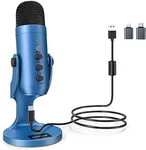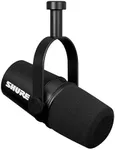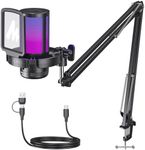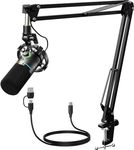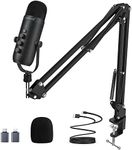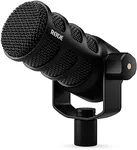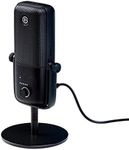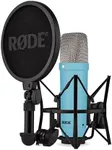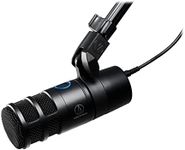Buying Guide for the Best Streaming Mic
Choosing the right streaming microphone can make a big difference in how you sound to your audience. Whether you’re gaming, podcasting, or hosting live streams, a good mic helps you come across as clear and professional. The best way to pick a microphone is to think about where and how you’ll use it, what kind of sound quality you want, and how much setup you’re comfortable with. Understanding the main features will help you find a mic that fits your needs and makes your voice shine.Microphone Type (Condenser vs. Dynamic)Microphones generally come in two main types: condenser and dynamic. Condenser mics are sensitive and pick up a lot of detail, making them great for quiet environments and capturing the full range of your voice. Dynamic mics are less sensitive and better at handling loud sounds or noisy rooms, so they’re good if you have background noise. If you stream in a quiet space and want crisp, detailed sound, a condenser mic is a good choice. If you have a lot of background noise or want something more forgiving, a dynamic mic might suit you better.
Connection Type (USB vs. XLR)Microphones connect to your computer or audio interface using either USB or XLR cables. USB mics are plug-and-play, easy to set up, and work directly with your computer, making them ideal for beginners or those who want a simple setup. XLR mics require an audio interface or mixer, which adds complexity but can offer better sound quality and more control. If you want something straightforward, go for USB. If you’re interested in upgrading your audio setup over time and want more flexibility, consider XLR.
Polar PatternThe polar pattern describes how a microphone picks up sound from different directions. The most common for streaming is cardioid, which captures sound mainly from the front and reduces noise from the sides and back. Other patterns like omnidirectional (picks up sound from all directions) or bidirectional (front and back) are less common for solo streaming. If you’re streaming alone, a cardioid pattern is usually best. If you plan to record with multiple people around one mic, look for a mic with switchable patterns.
Frequency ResponseFrequency response tells you the range of sounds a microphone can pick up, from low bass to high treble. A wider frequency response means the mic can capture more detail in your voice. For streaming, you want a mic that covers the typical vocal range, usually from around 80 Hz to 15 kHz or higher. If you have a deep voice, make sure the mic can handle lower frequencies. For most streamers, a standard vocal range is enough, but if you want to capture every nuance, look for a wider range.
Onboard ControlsSome microphones have built-in controls like mute buttons, gain knobs, or headphone jacks for real-time monitoring. These features make it easier to adjust your sound on the fly without needing extra software or hardware. If you want convenience and quick adjustments during your stream, look for a mic with these controls. If you prefer to manage everything through your computer or audio interface, onboard controls may be less important.
Build Quality and Mounting OptionsA sturdy microphone will last longer and handle regular use. Some mics come with stands or shock mounts to reduce vibrations and desk noise. If you move your mic around a lot or want to avoid picking up bumps and taps, look for a mic with a solid build and good mounting options. If your mic will stay in one place, a basic stand may be enough, but if you want flexibility, consider a mic that works with boom arms or has a shock mount.
